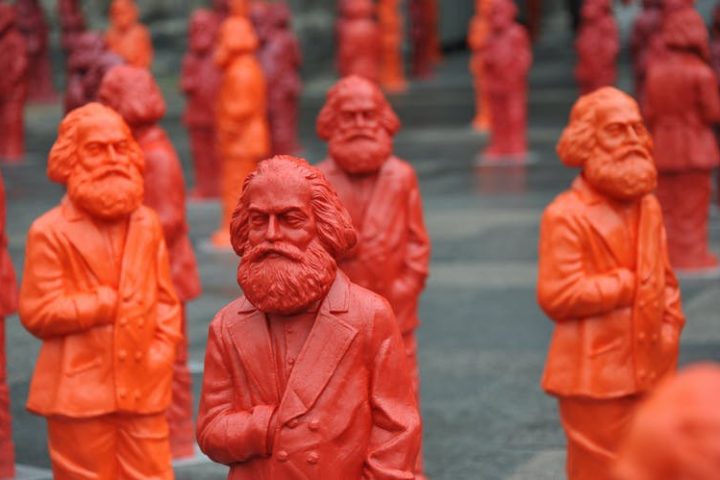In an ideal world, every extraordinary philosophical question would come with an extraordinary story telling the tale of how someone first thought of it. Unfortunately, we can only guess at what led a German philosopher, perhaps today best known for the Choco Leibniz biscuits later named after him, to come up with what is often described as the greatest philosophical question of all, namely: why is there something rather than nothing?
The philosopher was Gottfried Wilhelm Leibniz,
the man who also bequeathed us calculus and the binary system at the heart of modern computers. He died 300 years ago, on November 14, 1716.
Many earlier thinkers had asked why our universe is the way it is, but Leibniz went a step further, wondering why there is a universe at all. The question is a challenging one because it seems perfectly possible that there might have been nothing whatsoever – no Earth, no stars, no galaxies, no universe. Leibniz even thought that nothing would have been “simpler and easier”. If nothing whatsoever had existed then no explanation would have been needed – not that there would have been anyone around to ask for an explanation, of course, but that’s a different matter.
Leibniz thought that the fact that there is something and not nothing requires an explanation. The explanation he gave was that God wanted to create a universe – the best one possible – which makes God the simple reason that there is something rather than nothing.
In the years since Leibniz’s death, his great question has continued to exercise philosophers and scientists, though in an increasingly secular age it is not surprising that many have been wary of invoking God as the answer to it.
Quantum gods
One kind of answer is to say that there had to be something; that it would have been impossible for there to have been nothing. This was the view of the 17th century philosopher Spinoza, who claimed that the entire universe, along with all of its contents, laws and events, had to exist, and exist in the way it does. Einstein, who counted himself a follower of Spinoza’s philosophy, appears to have held a similar view.
Other scientists, such as theoretical physicist Laurence Krauss in his populist book A Universe from Nothing (2012), offer a more nuanced version of this answer to Leibniz’s great question. Krauss claims that our universe arose naturally and inevitably from the operation of gravity on the quantum vacuum, empty space teeming with virtual particles that spontaneously pop into existence before disappearing again. Krauss’s theory implies that there could not have been nothing because there has always been something: first there was gravity and the quantum vacuum, and out of that was born the universe as we know it.
Other theories in cosmology also seem to presuppose that there must always have been something in existence from which our universe arose, such as strings or membranes.
The trouble with such scientific answers to the question of “why there is something and not nothing” is that it is not clear why we should think that there had to be gravity, or the quantum vacuum, or strings, or even a universe at all. It seems entirely possible that instead of these things there could have been absolutely nothing.
What question?
Another response to Leibniz’s great question is simply to deny that it has an answer. The philosopher Bertrand Russell took this line in a famous radio debate in 1948. He was asked why he thought the universe exists, and responded “I should say that the universe is just there, and that’s all”.
On this account, the universe would be what philosophers call a brute fact – something that does not have an explanation. Russell’s point was not that humans hadn’t yet explained why there is something rather than nothing but that there is no possible explanation. Those who believe that our universe is part of the larger multiverse also take this line, suggesting that the multiverse – and hence our universe – has no ultimate explanation. Although it is now a popular response to Leibniz’s great question to say the universe is ultimately inexplicable, it does have the drawback of being intellectually unsatisfying (though of course that does not mean the response is false).
The most novel answer to Leibniz’s great question is to say that our universe exists because it should. The thinking here is that all possible universes have an innate tendency to exist, but that some have a greater tendency to exist than others. The idea is actually Leibniz’s, who entertained the thought that there may be a struggle for existence between possible worlds, with the very best one coming out on top as if through a process of virtual natural selection. In the end he did not accept the idea, and retreated instead to the more traditional view that the universe exists because God chose to make it so.
But the idea of a virtual struggle among possible universes has appealed to some modern philosophers, who have followed it to its logical conclusion and claimed that the possible universe with the greatest tendency to exist – which might be because it is the best, or because it contains some important feature such as the conditions that permit life to arise – will actually bring itself into existence.
According to this theory, our universe becomes actual not because God or anything else made it so but because it literally lifted itself out of non-existence and made itself actual. Weird? Yes. But we shouldn’t let that put us off. After all, an extraordinary philosophical question might just require an extraordinary answer.
Lloyd Strickland, Reader in Philosophy, Manchester Metropolitan University
This article is republished from The Conversation under a Creative Commons license. Read the original article.





Hi. I’m a believer in the idea that there has to be “something” but for the reason that I think even what we’ve traditionally considered to be “nothing” meets the definition (below) of an existent entity and is therefore a “something”. The rationale is below. In regard to the last idea that our universe exists because it somehow won the contest between possible universes doesn’t seem to work because in real “nothing”, even possibilities, and possible universes, would not be there. My explanation is below. Thanks.
Others have suggested that the seeming insolubility of the question “Why is there something rather than nothing?” is based on a flawed assumption. I agree and think the flawed assumption is that the situation we often visualize as being “absolute nothing” or the lack of all existent entities (e.g., the lack of all matter; energy; space/volume; time; abstract concepts; laws of physics, math and logic; possibilities; and minds and consciousness to consider this supposed “nothing”) is really the lack of all existent entities. Instead, I think this situation is itself an existent entity, or a “something”. If so, this means that “something” is necessary, or non-contingent because even what we used to think of as “absolute nothing” is a something. How can “nothing” be a “something”? In regard to the question “Why is there something rather than nothing?”, two possible solutions are:
A. “Something” has always been here.
B. “Something” has not always been here.
Choice A is possible but doesn’t explain anything; although, I’ll come back to it below. If we go with choice B, if “something” has not always been here, then “nothing” must have been here before it. In other words, there was “nothing” and now there is “something”. Now, if this supposed “nothing” before the “something” was truly the lack of all existent entities, there would be no mechanism present to change, or transform, this “nothingness” into the “something” that is here now. But, because we can see that “something” is here now, the only possible choice is that the supposed “nothing” we were thinking of was not in fact the lack of all existent entities, or absolute “nothing”. There must have been some existent entity, or “something”, present that could either have been the “something” we see now or that would have contained the mechanism needed to cause that “something” to appear. Because we got rid of all the existent entities we could think of, the only thing that could be an existent entity would be the supposed “nothing” itself. That is, it must in fact be a “something”. This is logically required if we go with choice B, and I don’t think there’s a way around that. Another way to say this is that if you start with 0 and end up with 1, you can’t do this unless somehow the 0 isn’t really 0 but is actually a 1 in disguise, even though it looks like 0 on the surface. Overall, this idea leads to the result that “something” is necessary because even what we used to think of as the lack of all existent entities, or “nothing”, is a “something”. Ironically, going with choice B leads to choice A. If what we used to think of as “absolute nothing” is actually an existent entity, or a “something”, this would always have been true, which means that this “something” would always have been here.
Instead of insisting that “nothing” can’t be a “something” and refusing to continue, it’s more useful to follow the logic described above and try to figure out how “nothing” can be a “something”. So, how can this be? I think it’s first important to try and figure out why any “normal” thing (like a book, or a set) can exist and be a “something”. I propose that a thing exists if it is a grouping that defines what is contained within. By defining what is contained within, it groups what is contained within into a single unit whole. This grouping together of what is contained within provides a surface, or boundary, that defines what is contained within, that we can see and touch as the surface of the thing and that gives “substance” and existence to the thing. In the case of a book, the grouping together of all the individual atoms and the bonds individual atoms creates a new and unique existent entity called a “book”, which is a different existent entity than the atoms and bonds inside considered individually. This grouping provides the surface that we see and can touch and that we call the “book”. Try to imagine a book that has no surface defining what is contained within. Even if you remove the cover, the collection of pages that’s left still has a surface. How do you even touch or see something without a surface? You can’t because it wouldn’t exist. As a different example, consider the concept of an automobile. This is a mental construct in the head that groups together individual concepts/constructs labeled “tire”, “engine”, “car body”, etc. into a new and unique entity labeled as the concept “automobile”. Here, the grouping is not seen as a physical surface but as the mental label “automobile” for the collection of subconcepts. But, this construct still exists because it’s a grouping defining what is contained within. One last example is that of a set. Does a set exist before the rule defining what elements are contained within is present? No. So, in conclusion, a grouping or relationship present defining what is contained within is an existent entity.
Next, apply this definition of why a thing exist to the question of “Why is there something rather than nothing?” To start, “absolute nothing”, or “non-existence”, is first defined to mean: no energy, matter, volume, space, time, thoughts, concepts, mathematical truths, etc.; and no minds to think about this “absolute lack-of-all”. Now, try to visualize this. When we get rid of all existent entities including matter, energy, space/volume, time, abstract concepts, laws or constructs of physics and math as well as minds to consider this supposed lack of all, we think what is left is the lack of all existent entities, or “absolute nothing” (here, I don’t mean our mind’s conception of this supposed “absolute nothing”, I mean the supposed “absolute nothing” itself, in which all minds would be gone). This situation is very hard to visualize because the mind is trying to imagine a situation in which it doesn’t exist. But, once everything is gone and the mind is gone, this situation, this “absolute lack-of-all”, would be it; it would be the everything. It would be the entirety, or whole amount, of all that is present. Is there anything else besides that “absolute nothing”? No. It is “nothing”, and it is the all. An entirety, whole amount or “the all” is a grouping that defines what is contained within (e.g., everything), which means that the situation we previously considered to be “absolute nothing” is itself an existent entity. The entirety/whole amount/”the all” grouping is itself the surface, or boundary, of this existent entity. Said another way, by its very nature, “absolute nothing”/”the all” defines itself and is therefore the beginning point in the chain of being able to define existent entities in terms of other existent entities. What this means is that “something” is necessary, or non-contingent, because even what we previously, and incorrectly, visualized as the lack of all existent entities, or “nothing”, is a “something. While this is not a new idea, a physical mechanism for how this can be is new.
One objection some could raise is that starting with “nothing” and seeing how it could be a “something” seems to imply a temporal change (first “nothing”, then “something”), but time would not exist until there was “something”. So, I don’t consider this a temporal change. Instead, I suggest that in switching between the perspective of visualizing “nothing” as just nothing at all and the other perspective of seeing it as a grouping and therefore a “something”, the mind can misinterpret this as a temporal change. It’s not. It’s just flipping back and forth between two different ways of thinking about the same thing: nothing.
Another objection that often comes up is that by talking about “nothing”, I’m reifying, or giving existence, to it, and this is what makes “nothing” seem like “something”. But, this objection is incorrect for the following reason. First, it conflates “nothing” itself and the mind’s conception of “nothing”. These are two different things. In “nothing” itself, our minds and our talking about “nothing” would not be present. This means that the mind’s conception of “nothing” and, therefore, our talking about “nothing” have no effect on “nothing” itself. That is, our talking about “nothing” will not reify “nothing” itself. Said another way, whether or not “nothing” itself exists is independent of our talking about it and is not dependent on being defined as the lack of “something”.
If you’re still reading at this point, thanks!, and there’s more detail at my website at:
https://sites.google.com/site/ralphthewebsite/